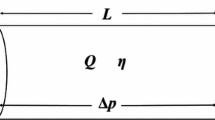Abstract
Simulating intrinsic deformation behaviors of guidewire and catheters for interventional radiology (IR) procedures, such as minimally invasive vascular interventions is a challenging task. Especially real-time simulations for interactive training systems require not only the accuracy of guidewire manipulations, but also the efficiency of computations. The insertion of guidewires and catheters is an essential task for IR procedures and the success of these procedures depends on the accurate navigation of guidewires in complex 3D blood vessel structures to a clinical target, whilst avoiding complications or mistakes of damaging vital tissues and blood vessel walls. In this paper, a novel elastic model for modeling guidewires is presented and evaluated. Our interactive guidewire simulator models the medical instrument as thin flexible elastic rods with arbitrary cross sections, treating the centerline as dynamic and the deformation as quasi-static. Constraints are used to enforce inextensibility of guidewires, providing an efficient computation for bending and twisting modes of the physically-based simulation model. We demonstrate the effectiveness of the new model with a number of simulation examples.
Similar content being viewed by others
References
Lunderquist, A., Ivancev, K., Wallace, S., Enge, I., Laerum, F., Kolbenstvedt, A.N.: The acquisition of skills in interventional radiology by supervised training on animal models: A three year multicenter experience. Cardiovasc. Interv. Radiol. 18(4), 209–211 (1995)
Seymour, N.E., Gallagher, A.G., Roman, S.A., O’Brien, M.K., Bamsal, V.K., Andersen, D.K., Satava, R.M.: Virtual reality training improves operating room performance: Results of a randomized, double-blinded study. Ann. Surg. 236(4), 458–463 (2002)
Cavusoglu, M., Tendick, F., Cohn, M., Sastry, S.: A laparoscopic telesurgical workstation. IEEE Trans. Robot. Autom. 15(4), 728–739 (1999)
Bergou, M., Wardetzky, M., Robinson, S., Audoly, B., Grinspun, E.: Discrete elastic rods, SIGGRAPH. ACM Trans. Graph. 27(3), 63:1–63:12 (2008)
Luboz, V., Lai, L., Blazewski, J., Gould, D., Bello, F.: A virtual environment for core skills training in vascular interventional radiology. In: Proceedings of the 4th International Symposium on Biomedical Simulation, vol. 5104, pp. 215–220 (2008)
Cotin, S., Duriez, C., Lenoir, J., Neumann, P., Dawson, S.: New approaches to catheter navigation for interventional radiology simulation. In: Medical Image Computing and Computer-assisted intervention, vol. 8, pp. 534–542 (2005)
Alderliesten, T., Konings, M.K., Niessen, W.J.: Modeling friction, intrinsic of curvature, and rotation guidewires for simulation of minimally invasive vascular interventions. IEEE Trans. Biomed. Eng. 54(1), 29–38 (2007)
Cotin, S., Dawson, S., Meglan, D., Shaffer, D., Ferrell, M., Sherman, P.: Icts, an interventional cardiology training system. In: Westwood, J.D., et al. (ed.) Proceedings of Medicine Meets Virtual Reality, pp. 59–65. IOS Press, Amsterdam (2000)
Lenoir, J., Meseure, P., Grisoni, L., Chaillou, C.: Surgical thread simulation. In: MS4CMS (Proc. of ESAIM), vol. 12, pp. 102–107 (2002)
Nowinski, W.L., Chui, C.K.: Simulation of interventional neuroradiology procedures. In: MIAR, pp. 87–94 (2001)
Alderliesten, T.: Simulation of Minimally-Invasive Vascular Interventions for Training Purposes. Ph.D. Dissertation, Utrecht University, December 2004
Van Der Heijden, G.H.M., Neukirch, S., Goss, V.G.A., Thompson, J.M.T.: Instability and self-contact phenomena in the writhing of clamped rods. Int. J. Mech. Sci. 45, 161–196 (2003)
Falk, R.S., Xu, J.-M.: Convergence of a second order scheme for the nonlinear dynamical equations of elastic rods. SJNA 32(4), 1185–1209 (1995)
Lin, C.-C., Schwetlick, H.R.: On the geometric flow of Kirchhoff elastic rods. SIAM J. Appl. Math. 65(2), 720–736 (2004)
Pai, D.K.: STRANDS: interactive simulation of thin solids using Cosserat models. Comput. Graph. Forum 21, 3 (2004)
Bertails, F., Audoly, B., Cani, M.-P., Querleux, B., Leroy, F., Le’ve’que, J.-L.: Super-helices for predicting the dynamics of natural hair. ACM Trans. Graph. 25(3), 1180–1187 (2006)
Bertails, F.: Linear time super-helices. Comput. Graph. Forum 28(2), 417–426 (2009)
Spillmann, J., Teschner, M.: CORDE: Cosserat rod elements for the dynamic simulation of one-dimensional elastic objects. In: Proceedings of the 2007 Symposium on Computer Animation, Eurographics Association, pp. 63–72 (2007)
Botsch, M., Sorkine, O.: On linear variational surface deformation methods. IEEE Trans. Vis. Comput. Graph. (TVCG) 14(1), 213–230 (2008)
Hughes, T.J.R.: The Finite Element Method. Linear Static and Dynamic Finite Element Analysis. Dover, New York (2000)
Tang, W., Niquin, C., Schildknecht, A., Wan, T.R.: Fast and accurate finite element method for deformation animations. In: Proceedings of Theory and Practice of Computer Graphics. Cardiff University, Cardiff (2009)
Ogata, N., Goto, K., Uda, K.: An evaluation of the physical properties of current microcatheters and guidewires. Interv. Neuroradiol. 3, 65–80 (1997)
Schroder, J.: Technology assessment: the mechanical properties of guidewires, part III: sliding friction. Cardiovasc. Interv. Radiol. 16, 93–97 (1993)
Webster, R.J. III, Cowan, N.J., Chirikjian, G., Okamura, A.M.: Nonholonomic modeling of needle steering. In: 9th International Symposium on Experimental Robotics, June 2004
Duindam, V., Alterovitz, R., Sastry, S., Goldberg, K.: Screw-based motion planning for bevel-tip flexible needles in 3d environments with obstacles. In: IEEE Intl. Conf. on Robot. and Autom., pp. 2483–2488, May 2008
Author information
Authors and Affiliations
Corresponding author
Rights and permissions
About this article
Cite this article
Tang, W., Lagadec, P., Gould, D. et al. A realistic elastic rod model for real-time simulation of minimally invasive vascular interventions. Vis Comput 26, 1157–1165 (2010). https://doi.org/10.1007/s00371-010-0442-1
Published:
Issue Date:
DOI: https://doi.org/10.1007/s00371-010-0442-1




